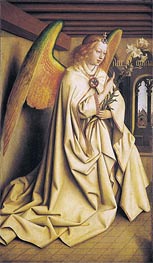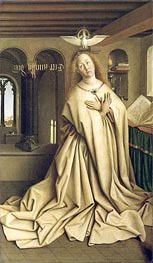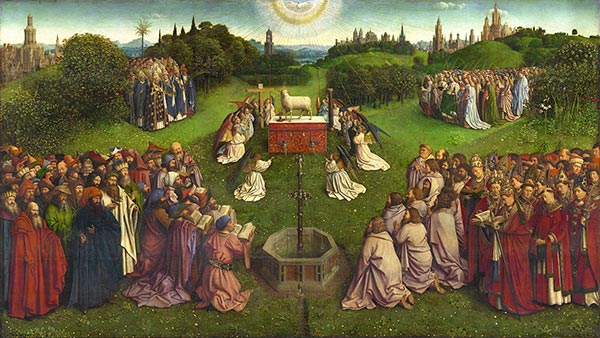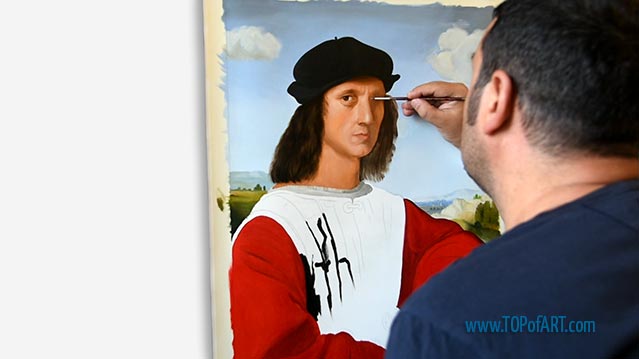The Adoration of the Mystic Lamb (The Ghent Altarpiece), 1432 Jan van Eyck (b.1395-1441)
Location: Saint Bavo Cathedral Ghent BelgiumOriginal Size: 137.7 x 242.3 cm
Own a museum-quality reproduction of The Adoration of the Mystic Lamb (The Ghent Altarpiece) by Jan van Eyck (1432), exclusively hand-painted in oils on linen canvas by European artists with academic training. Each masterpiece is created with meticulous craftsmanship, capturing the exceptional quality and authentic brushwork of the original painting.
Oil Painting Reproduction
If you want a different size than the offered
Description
Painted by European Аrtists with Academic Education
Museum Quality
+ 4 cm (1.6") Margins for Stretching
Creation Time: 8-9 Weeks
Creation Process
We create our paintings with museum quality and covering the highest academic standards. Once we get your order, it will be entirely hand-painted with oil on canvas. All the materials we use are the highest level, being totally artist graded painting materials and linen canvas.
We will add 1.6" (4 cm) additional blank canvas all over the painting for stretching.
High quality and detailing in every inch are time consuming. The reproduction of Jan van Eyck also needs time to dry in order to be completely ready for shipping, as this is crucial to not be damaged during transportation.
Based on the size, level of detail and complexity we need 8-9 weeks to complete the process.
In case the delivery date needs to be extended in time, or we are overloaded with requests, there will be an email sent to you sharing the new timelines of production and delivery.
TOPofART wants to remind you to keep patient, in order to get you the highest quality, being our mission to fulfill your expectations.
We not stretch and frame our oil paintings due to several reasons:
Painting reproduction is a high quality expensive product, which we cannot risk to damage by sending it being stretched.
Also, there are postal restrictions, regarding the size of the shipment.
Additionally, due to the dimensions of the stretched canvas, the shipment price may exceed the price of the product itself.
You can stretch and frame your painting in your local frame-shop.
Delivery
Once the painting The Adoration of the Mystic Lamb (The Ghent Altarpiece) is ready and dry, it will be shipped to your delivery address. The canvas will be rolled-up in a secure postal tube.
We offer free shipping as well as paid express transportation services.
After adding your artwork to the shopping cart, you will be able to check the delivery price using the Estimate Shipping and Tax tool.
Museum Quality
The paintings we create are only of museum quality. Our academy graduated artists will never allow a compromise in the quality and detail of the ordered painting. TOPofART do not work, and will never allow ourselves to work with low quality studios from the Far East. We are based in Europe, and quality is our highest priority.
Additional Information
Van Eyck’s color palette is a tour de force in harmonious contrasts. The grassy expanse is rendered in several tones of green, meticulously modulated so the terrain acquires a soft gradient that recedes gently into the distance. Rich reds draw attention to vestments worn by male saints or to the altar itself, whose surface is replete with subtle patterns. Soft pinks appear in flowing robes that cluster around the center, balancing the more vibrant blues and reds. Overhead, the sky transitions from a delicate turquoise near the horizon to a slightly darker cobalt as it curves across the top of the panel, creating a sense of infinite depth. The interplay of these colors evokes both a physical environment and a spiritual reality, heightening an otherworldly atmosphere that merges earthly detail with celestial wonder.
Van Eyck’s remarkable use of oil paint - a relatively emerging technique in early 15th-century Northern Europe - allowed him to achieve a luminosity unattainable with traditional tempera. The layers of translucent glaze serve to unify the composition, imbuing each hue with an internal glow. In close viewing, one discerns brushwork that is at times painstakingly refined in small details, at other times broader to suggest texture in fabrics or the sheen of metalwork. Such a method results in the delicate rendering of fabrics that appear almost tangible, reflecting light in minuscule folds. The angels’ wings, each feather meticulously tinted, reveal innumerable color gradations. These transitions are handled with such finesse that the viewer might sense movement, as if the very air around them vibrates with color.
Compositionally, the painting masterfully balances vertical and horizontal tensions. The vertical axis - from the fountain, through the Lamb, up toward the hovering dove in a circle of radiating beams - is a clear signal of the theological thrust. Equally persuasive are the horizontal groupings: male martyrs on one side, female martyrs on the other, Old Testament prophets to the left, New Testament apostles to the right. The placement of these figures suggests a collective momentum converging on the altar, the high point in both spiritual significance and pictorial design. In the distance, delicate spires allude to Jerusalem, and this subtle urban skyline pulls the eye deeper into the painting, reinforcing a cyclical journey from foreground to background and back again. So meticulously arranged is the scene that the viewer’s gaze glides seamlessly from the saints in the foreground to the luminous sky above.
Though the painting vibrates with highly specific devotional significance, Van Eyck situates it within the broader currents of the 15th-century Northern Renaissance. The precision in botanical depiction - from daisies and peonies to fruit-bearing trees - attests to a new interest in the natural world as worthy of close observation. Traditional Medieval art favored symbolic representation, yet here, the viewer encounters the recognizable forms of an earthly garden, albeit one miraculously touched by divine light. The painter’s dedication to empirical detail, combined with the layered references to scripture and liturgy, reflects a society shifting to a deeper humanistic exploration of both sacred and mundane realities.
Throughout, Van Eyck incorporates references that would have resonated with contemporary viewers. The Lamb, its breast pierced yet seemingly untroubled, represents the steadfast acceptance of sacrifice, made visible in the rivulet of blood pouring into a chalice. This calm expression was a radical departure from earlier depictions of agony. The dovetailing of theological narrative and everyday observation is likewise present in the gathering of historical popes and an antipope, suggesting contemporary issues of ecclesiastical dispute subtly woven into a biblical framework. The elaborate altar inscriptions, drawn directly from scripture, and the arrangement of angels wielding instruments of Christ’s Passion, might remind the devout viewer of liturgical rites and beliefs that shaped daily life in 15th-century Ghent.
The overall effect, then, is both grand and intimate. Van Eyck alludes to cosmic truths in the radiant light that filters through the painting, yet he anchors these truths in tangible, meticulously observed details: the flecks of golden rays illuminating the saints’ robes, the gem-like clarity of water in the fountain, and the minute flora dotting the meadow. The viewer is invited to contemplate the painting’s underlying message - the lamb as a unifying sacrifice - while simultaneously appreciating its exacting representation of the physical world. If earlier artists tended toward flat gold backgrounds and abstract symbols, here one witnesses a new immersion into the observable universe, enhanced by glazes that capture light as if in a prism.
Standing before this altarpiece, one senses the convergence of art, devotion, and scholarship. It is neither overwhelmed by pathos nor reduced to mere dogma. Instead, it celebrates complexity - the complexity of faith, history, and nature. Van Eyck does not simply depict a theological concept; he renders it with such precision that the scene resonates on multiple levels, intellectually and visually. In doing so, he demonstrates an understanding that the divine, if it is to be perceived, must also be encountered in the careful rendering of the concrete world. This nuanced balance is likely what has earned the painting its enduring place in the canon of early Netherlandish art, for it continues to reward extended observation and reflective study, centuries after its creation.
Such reflective study is indeed the painting’s greatest invitation. Beyond the theological layers, the Adoration of the Mystic Lamb prompts one to linger over the orchestrated distribution of color, the deliberate layering of oil paint, and the subtle geometry that guides every figure’s position. In a single expansive field, Van Eyck fuses heaven and earth, intangible faith and tactile reality, into a cohesive vision. To engage with this work is to engage with the meticulous artistry of its maker and the cultural tapestry of the early 15th century, each insight quietly affirming how closely observation and reverence were, and remain, interlinked.

The Angel Gabriel passes the Message to Maria (The Ghent Altarpiece) 1432
$2862
$61.75
Jan van Eyck
Original Size:137.7 x 242.3 cm
Saint Bavo Cathedral, Ghent, Belgium

Virgin Annunciate (The Ghent Altarpiece) 1432
$3108
$61.75
Jan van Eyck
Original Size:137.7 x 242.3 cm
Saint Bavo Cathedral, Ghent, Belgium

John the Baptist (The Ghent Altarpiece) 1432
$1959
$61.75
Jan van Eyck
Original Size:137.7 x 242.3 cm
Saint Bavo Cathedral, Ghent, Belgium

The Apostle John (The Ghent Altarpiece) 1432
$1934
$61.75
Jan van Eyck
Original Size:137.7 x 242.3 cm
Saint Bavo Cathedral, Ghent, Belgium

Judocus Vyd (The Ghent Altarpiece) 1432
$2325
$61.75
Jan van Eyck
Original Size:137.7 x 242.3 cm
Saint Bavo Cathedral, Ghent, Belgium

